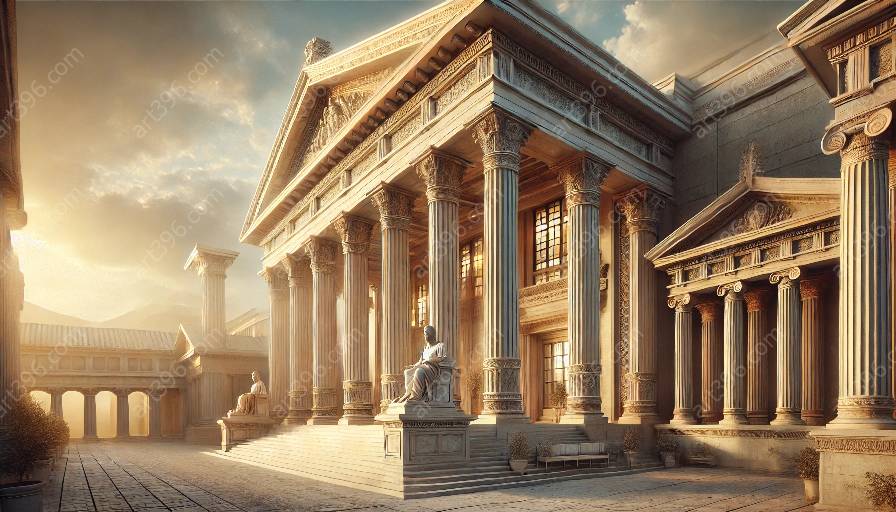The construction of the Parthenon, a magnificent temple atop the Acropolis in Athens, Greece, stands as a testament to the advanced engineering prowess of the ancient Greeks and the evolution of Greek architecture. This monumental structure showcases the technological and artistic achievements of the ancient Greeks, serving as an enduring symbol of their architectural innovation and precision.
The Parthenon: An Architectural Marvel
Built in the mid-5th century BC, the Parthenon was dedicated to the Goddess Athena, the patron deity of Athens. It was designed by the renowned architects Ictinus and Callicrates under the supervision of the sculptor Phidias. The temple was constructed using a combination of Doric and Ionic architectural styles, reflecting the Greeks' mastery of proportion, symmetry, and visual harmony.
The innovative architectural elements utilized in the construction of the Parthenon exemplify the advanced engineering techniques employed by the ancient Greeks. The temple's impressive features include its massive colonnades, intricately carved metopes, and pediment sculptures, which showcase the Greeks' exceptional craftsmanship and attention to detail.
Advanced Construction Techniques
One of the most remarkable aspects of the Parthenon's construction is its extensive use of marble, a notoriously challenging material to work with due to its susceptibility to fractures and shifting under pressure. To overcome these challenges, the ancient Greek architects and craftsmen developed innovative techniques such as precision cutting and fitting of marble blocks, as well as the use of metal dowels and clamps to reinforce the structural stability of the temple.
The Greeks' mastery of architectural geometry and mathematical principles is evident in the precise alignment and positioning of the Parthenon's columns, triglyphs, and other architectural features. The incorporation of optical refinements, such as slight curvature and tapering, further demonstrates the Greeks' sophisticated understanding of visual perception and architectural optics.
Innovation in Architectural Design
The construction of the Parthenon also revealed the ancient Greeks' pioneering approach to architectural design and construction management. The implementation of an advanced scaffolding system, along with the use of cranes and hoists, facilitated the assembly of the temple's massive stone components with remarkable precision and efficiency.
Moreover, the Greeks' utilization of innovative construction materials, such as iron clamps and wooden pegs, contributed to the structural integrity and longevity of the Parthenon, enabling it to withstand the test of time and natural elements for centuries.
Leveraging Mathematical and Scientific Knowledge
Furthermore, the construction of the Parthenon underscored the Greeks' deep understanding of mathematical and scientific principles, which played a crucial role in the realization of this architectural masterpiece. The precise calculation of dimensions, angles, and proportions, coupled with the use of advanced surveying and leveling techniques, enabled the ancient Greeks to achieve unparalleled accuracy in the execution of the temple's architectural elements.
By employing their expertise in mathematics, geometry, and physics, the Greeks pioneered innovative solutions to complex engineering challenges, elevating the Parthenon to the pinnacle of ancient architectural achievement. The fusion of artistry and scientific knowledge in the construction of the Parthenon exemplifies the holistic approach of the ancient Greeks to architectural design and construction.
Legacy of Architectural Excellence
The enduring legacy of the Parthenon as a marvel of ancient engineering and Greek architecture continues to influence architectural practices and inspire admiration for the ingenuity of the ancient Greeks. Its timeless significance transcends millennia, serving as a testament to the advanced engineering capabilities and cultural achievements of one of the most remarkable civilizations in history.
In conclusion, the construction of the Parthenon stands as a remarkable testament to the advanced engineering capabilities and architectural innovation of the ancient Greeks. Through their mastery of materials, construction techniques, and mathematical principles, the Greeks achieved a level of architectural excellence that continues to captivate and inspire people around the world. The Parthenon remains an enduring symbol of the ingenuity and creative vision of the ancient Greeks, perpetuating their legacy as pioneers of architectural marvels.

















































































